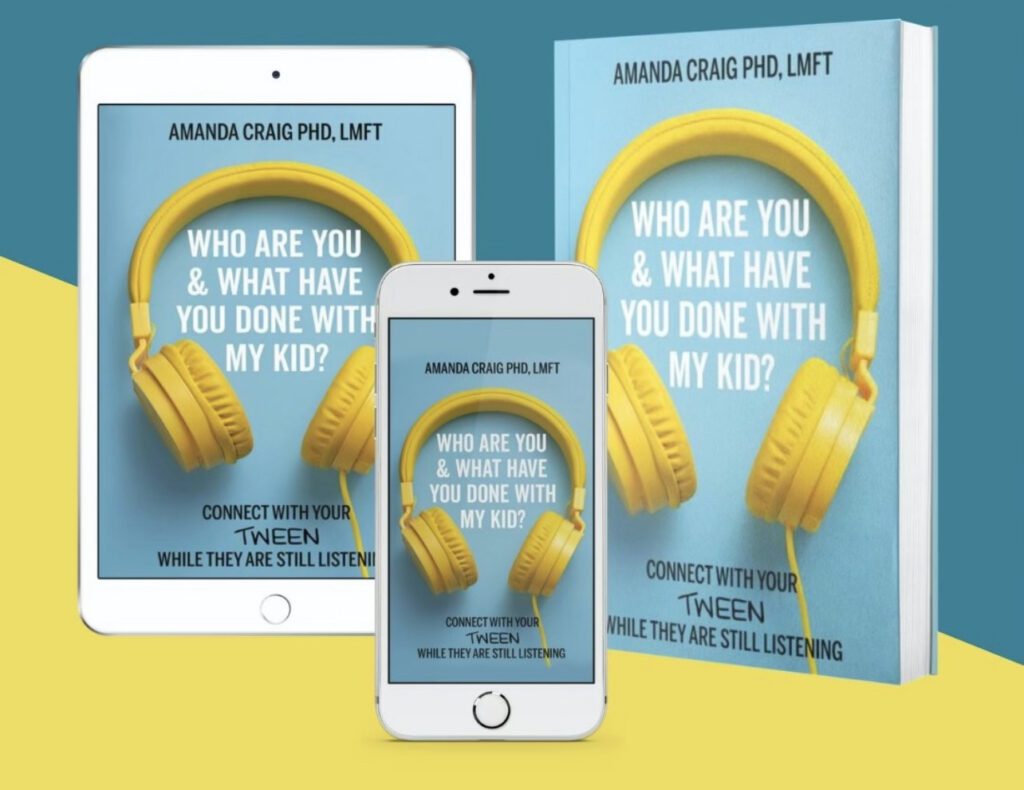
Forging a strong relationship with your children while they are in their tween years (specifically, 9 to 12 years old) can help you all better weather the teenage years and beyond. But connecting with your tween can sometimes feel like a tall task. A new book from Licensed Marriage and Family Therapist (LMFT) Amanda Craig, Who Are You & What Have You Done with My Kid?: Connect with Your Tween While They Are Still Listening, is helping parents do just that.
“After several years of running a successful private group practice in Manhattan, in 2016 I decided to bring services to Connecticut where I provide individual, couples, and family therapy,” says Amanda. “In addition to my practice, I work with parents, kids, and families through speaking events and tween pop-up workshops.”
The Local Moms Network spoke to Amanda about her new book, how she came to dedicate her life to helping families and how to connect with this age group that doesn’t seem to get the attention to others, like toddlers, or teenagers, do—but should.
How did you become so interested in mental health?
In my tween years, I went to therapy as part of a juvenile diversion program. I found it so helpful in building my self-esteem, finding my voice, and getting reassurance that I mattered in the world. I realized I wanted to help families and kids who were feeling stuck, sad, and disconnected. I found talking about and gaining insight into my own feelings was a way to process adversities, heal from challenging experiences, and ultimately feel better.
Why did you write this book?
Life is too short to be in long term pain. The message that came from the book is a sentiment I share everyday in session with clients – it centers around the importance of an emotional connection with those we love.
When we feel an emotional connection we are our best self. And when we feel disconnected we are distracted and unsure. When we are unsure of self, unsure of our potential, the clarity starts to darken and the anxieties or depressions of uncertainty and loneliness start to creep in.
My hope is people take things away from the book that either lead them to lean into relationships and the emotional connection that is there or move away from relationships that are not working and are leaving them feeling more sadness than happiness.
Life is too short to be in long term pain.
Why tweens?
Most people seem to think you are either a kid or a teenager. You’re in elementary, middle or high school. We think 12-18 years old are the teen years. But when we break out this group of 9 – 12-year-olds – it’s not middle school but a bit before that – we see the brain changes before puberty. It’s a time when we parents still have a seat at the table.
In a few short years friendships and peer relationships will really be sitting in our seat. If we connect with our tweens we build a trusting foundation for the stormy years of teens to come. They will trust us, they will know we have their back, and then will feel safe sharing their ups and downs because they know their voice matters.
What’s the one thing we can do every day to connect with our tween?
Show up. It seems obvious but when you really break it down it means put the phone down, go into their space in their time and hang, talk about their topics, look at them when they talk, and bring levity, be a moment of joy. When we do, we tell them they matter.
TRY THIS: Do an experiment and watch for a day how often you listen while you’re multi-tasking or interrupt with a directive to your child.
If your child won’t talk much, how do you get to know them, how do you know what’s going on?
Emotional connection is essential for bonding with our kids, tweens, teens and even in our partnerships.
At its core, emotional connection is about love. We are hardwired to love and be loved. When we love or feel loved by someone, we feel it throughout our body – heartbeat, breathing patterns, energy level, digestion, sense of being rested… And when we feel distant from someone important, we feel disconnected – sadness, racing thoughts, emptiness in our body, digestion changes, emotional eating (or no eating), sweating – and our heart hurts which is why we call it brokenhearted, because our heart actually aches.
An interaction happens between two people, our brain takes it in and sends messages through our entire body via the nervous system. The messages sent are either calming, comforting, safe and secure or that we are in danger.
So, how do we emotionally connect?
Amanda’s 4 Pillars of Emotional Connection
I see you.
A parent makes space and really listens to the child’s perspective. The parent puts his or her perspective aside to really hear them. Regardless of what I think of screen time, what does my tween think? What do they get out of screen time? Do they notice at some point the dumbs set in? What do they like best on screens? It’s like creating a painting and you want to know the color, hues and textures they are using to explain their reality.
It isn’t what we think about them or their story or even how true we think their story is, it is really seeing them for who they say they are. This leaves our tweens feeling like their voice is heard and what they think matters. When they feel like they matter they are more apt to take healthy risks and feel seen by others, more apt to raise their hand in class and participate in new activities.
I want to know you.
If to see them is to see their perspective, to know them is to look deeper at their emotions and understand how they feel about their day-to-day life. It is the difference between “how was your day” and “how did you experience your day.” This is where we learn about their emotional awareness, how they express emotions and how they regulate their emotions.
We talk with them about feelings, give them space to brainstorm what to call their emotions, express and regulate their emotions and moods. Equally important is also to model how we cope with stress, emotions, and relationships. When we empathize and give them space to think through emotions and coping, we provide an opportunity for them to develop confidence in self and empathy for others.
I am here for you.
This has a couple parts. We want our tweens to feel support. We want them to know we, as parents, will have their back. We will support them through their struggles. We will also be there to play, have rituals that we do together, make memories that are fun, have inside jokes that only we know.
Second, because we want tweens to feel community, we will expose them to other adults and people that will be an extended support system as they grow. In addition, other adults will model behaviors we want them to see and practice.
Lastly, we want to expose them to cultures, places and people that are different than they are. When we do, we teach them that differences are rich. They will be able to walk into rooms with people unlike them and be inclusive, to know how to invite others to the table, and to know that people different from them bring unique valuable qualities and their voices should be heard. This is where humanity is at its best.
I will keep you safe.
As important as it is to start showing our tween they matter and have a voice in our home, we must also be willing to have boundaries. When tweens have boundaries, they learn what guilt or regret feels like, they practice delayed gratification and they see what it feels like to see things through, to do hard things and come out the other side. This is how resilience is built.
Natural consequences are a parent’s best friend. Sometimes the world will be their lesson, that helps us parents. It can be a really important teaching moment.

This is part one of our “Tween Tips” series. Next Amanda will teach us how to set boundaries and what never to say to your child.
For more on Amanda, including her practice and her Fairfield, CT-based pop-up series, visit her website, Instagram page, and her practice’s website, Manhattan Marriage and Family Therapy.
